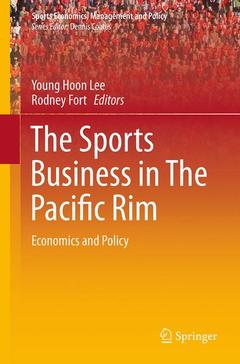Description
The Sports Business in The Pacific Rim, 2015
Economics and Policy
Sports Economics, Management and Policy Series, Vol. 10
Language: English
Subjects for The Sports Business in The Pacific Rim:
The Sports Business in The Pacific Rim
Publication date: 09-2016
Support: Print on demand
Publication date: 09-2016
Support: Print on demand
The Sports Business in The Pacific Rim
Publication date: 11-2014
385 p. · 15.5x23.5 cm · Hardback
Publication date: 11-2014
385 p. · 15.5x23.5 cm · Hardback
Description
/li>Contents
/li>Comment
/li>
Following consistent and rapid general economic growth, Pacific Rim countries have grown as a major force in sports. Australia, China, Japan and Korea populated the top ten medals list at the 2012 London Olympics. Pacific Rim countries are major consumers of international sports and domestic professional sports have expanded continuously over time. Nippon Professional Baseball and the Korean Baseball Organization are the second and third largest baseball leagues measured by attendance and revenue following Major League Baseball in the U.S. This book also includes event studies of team ownership, assessment of human capital markets, analysis of the relationship between attendance and competitive balance, the components of fan demand in common the world over, and business decisions concerning attendance and pricing. There is already demand for comprehensive study of the sports business in the Pacific Rim as witnessed by this growth. This book will be of interest of researchers studying and/or teaching in the fields of sports economics and sports management as well as a general audience interested in business governance around the world.
Section 1: Baseball.- Japan (NPBL).- Impact of Purchasing or Selling a Baseball Team on the Profits of the Parent Company: Event Study.- Does Educational Background Affect Performance and Second Career of Athletes? Empirical Analysis of Japanese Professional Baseball Players.- Customer Discrimination and Outcome Uncertainty in the World Baseball Classic: The Case of Taiwan Television Audience.- Korea (KBO/KPBL).- KBO and International Sports League Comparisons.- Section 2: Basketball.- China (CBA).- Attendance and Balance in the Chinese Basketball Association.- Korea (KBL).- Analysis on the Effects of Foreign Players in the Korean Basketball League on Fan Demand.- Australia (NBL and BA).- The Economic History of Governance changes in the National Basketball League and Basketball Australia over the Last 30 Years.- Section 3: Soccer.- China.- Chinese Soccer Attendance and Pricing.- Japan (J.League).- The J.League and the World Cup.- Korea (K-League).- The Role of Place Attachment on Local Sport Team Identity Development: A Case of A Korean Professional Soccer Club.- Governance Structure and Fan Loyalty in the K-League.- Section 4: Horse Racing and Sumo.- Australia (Horse Racing).- Sweated Labour, Literally Speaking: The Case of Australian Jockeys.- Japan (Sumo).- Where Versatility Matters: Evidence from Sumo Wrestling.- Section 5: Across Sports/Across Borders.- Generic Models of Sports Governance and Their Potential for Sustainability: Bowling, Hockey, and Swimming in Australia.- The Effects of Owning and Discarding a Professional Sports Team on Firm Values: Asian Evidence.- A Comparison of Collective Bargaining: The Australian Football League and Rugby League.- Business and Finance of Sports Leagues in East Asia.- The Sports Experience for the School-Aged Children and their Subsequent Outcomes Later on in Life in Japan.- The Evolution of Sports Broadcasting in Korea.- Effects of Pro Sports Leagues on Community Formation and SportsParticipation: A Comparison of Baseball and Soccer in Japan.
Employs economic analysis to examine the institutions that exist in the Pacific Rim sporting world Provides industry studies and ownership model analysis of popular team sports Uses data generated in Pacific Rim sports markets to illustrate the uncertainty of outcome hypothesis, competitive balance, attendance, pricing, fan loyalty, the effect of governance structure and substitution effects Includes supplementary material: sn.pub/extras
© 2024 LAVOISIER S.A.S.




